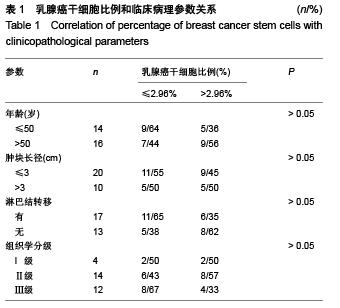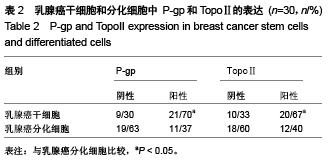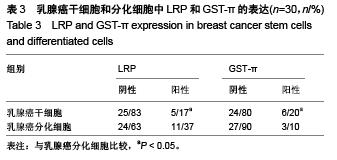| [1] 高国璇,辛灵,刘荫华,等.St Gallen国际乳腺癌会议专家共识10年历程回顾[J].中国实用外科杂志,2013,34(1):70-72.[2] 陈基善.早期乳腺癌新辅助化疗联合保乳术治疗的临床效果分析[J].中国当代医药,2011,18(10):30-31.[3] 罗静,李幼平,吴泰相,等.新辅助化疗对可手术乳腺癌保乳手术影响的系统评价[J].中国循证医学杂志,2008,8(7):551-557.[4] 左文述,魏玲,宋现让,等.浸润性乳腺癌组织中P-糖蛋白以及肺耐药蛋白和多药耐药相关蛋白表达的临床意义[J].中华医学杂志, 2006,86(44):3142-3145.[5] 王国方,唐敏.新辅助化疗联合保乳手术治疗中晚期乳腺癌的临床应用价值[J].中国医学创新,2012,9(25):8-9.[6] Honeth G, Bendahl PO, Ringnér M, et al. The CD44+/CD24- phenotype is enriched in basal-like breast tumors. Breast Cancer Res. 2008;10(3):R53.[7] Cuppone F, Bria E, Vaccaro V, et al. Magnitude of risks and benefits of the addition of bevacizumab to chemotherapy for advanced breast cancer patients: Meta-regression analysis of randomized trials. J Exp Clin Cancer Res. 2011;30:54.[8] Tanaka H, Nakamura M, Kameda C, et al. The Hedgehog signaling pathway plays an essential role in maintaining the CD44+CD24-/low subpopulation and the side population of breast cancer cells. Anticancer Res. 2009;29(6):2147- 2157.[9] Leonard R, O'Shaughnessy J, Vukelja S, et al. Detailed analysis of a randomized phase III trial: can the tolerability of capecitabine plus docetaxel be improved without compromising its survival advantage. Ann Oncol. 2006; 17(9): 1379-1385.[10] 朱立元,龙光辉,于志强,等.保留乳房的改良式乳腺癌根治术21例报告[J].中国普通外科杂志,2003,12(5):332-333. [11] Taguchi T, Aihara T, Takatsuka Y, et al. Phase II study of weekly paclitaxel for docetaxel-resistant metastatic breast cancer in Japan. Breast J. 2004;10(6):509-513.[12] 林帅,吴诚义. 乳腺癌中CD44+/CD24-表型及乳腺癌分子亚型的分布及意义[J].临床与实验病理学杂志, 2010,26(3):289-292.[13] 杨国华,陈晓耕.乳腺癌干细胞与乳腺癌转移相关因素的研究[J].中国普通外科杂志,2009,18(5):454-456.[14] Trock BJ, Leonessa F, Clarke R. Multidrug resistance in breast cancer: a meta-analysis of MDR1/gp170 expression and its possible functional significance. J Natl Cancer Inst. 1997;89(13):917-931.[15] 左文述,魏玲,宋现让,等.浸润性乳腺癌组织中 P-糖蛋白以及肺耐药蛋白和多药耐药相关蛋白表达的临床意义[J]. 中华医学杂志,2006, 86(44):3142-3145.[16] Kakarala M, Wicha MS.Implications of the cancer stem-cell hypothesis for breast cancer prevention and therapy.J Clin Oncol. 2008;26(17):2813-2820.[17] Chute JP, Muramoto GG, Whitesides J, et al. Inhibition of aldehyde dehydrogenase and retinoid signaling induces the expansion of human hematopoietic stem cells. Proc Natl Acad Sci U S A. 2006;103(31):11707-11712.[18] Glinsky GV, Berezovska O, Glinskii AB. Microarray analysis identifies a death-from-cancer signature predicting therapy failure in patients with multiple types of cancer. J Clin Invest. 2005;115(6):1503-1521.[19] Lu Z, Jia J, Di L, et al. DNA methyltransferase inhibitor CDA-2 synergizes with high-dose thiotepa and paclitaxel in killing breast cancer stem cells. Front Biosci (Elite Ed). 2011;3: 240-249.[20] 任传利,韩崇旭,王大新,等. EpCAM抗体偶联纳米磁珠阳性分离实体瘤外周血循环肿瘤细胞方法的建立[J].中华检验医学杂志, 2011,34(3):218-223.[21] Biron P, Durand M, Roché H, et al. Pegase 03: a prospective randomized phase III trial of FEC with or without high-dose thiotepa, cyclophosphamide and autologous stem cell transplantation in first-line treatment of metastatic breast cancer. Bone Marrow Transplant. 2008;41(6):555-562.[22] 谢轶群,施俊义,李曦洲.GATA3 在乳腺癌组织中的表达及其与 ER 表达的关系[J].中国肿瘤生物治疗杂志,2011,18(1): 89-91.[23] Kurebayashi J, Kanomata N, Moriya T, et al. Preferential antitumor effect of the Src inhibitor dasatinib associated with a decreased proportion of aldehyde dehydrogenase 1-positive cells in breast cancer cells of the basal B subtype. BMC Cancer. 2010;10:568.[24] 王启俊,祝伟星,邢秀梅.北京城区女性乳腺癌发病死亡和生存情况 20 年监测分析[J].中华肿瘤杂志,2006,28(3):208-210.[25] 孟洁,郎荣刚,范宇,等.年轻乳腺癌患者的病理学和生物学特征及其与预后的关系[J].中华肿瘤杂志,2007, 29(4):284-288.[26] Cameron D, Casey M, Press M, et al. A phase III randomized comparison of lapatinib plus capecitabine versus capecitabine alone in women with advanced breast cancer that has progressed on trastuzumab: updated efficacy and biomarker analyses. Breast Cancer Res Treat. 2008;112(3):533-543.[27] Carlson LE, Koski T, Glück S. Longitudinal effects of high-dose chemotherapy and autologous stem cell transplantation on quality of life in the treatment of metastatic breast cancer. Bone Marrow Transplant. 2001;27(9):989-998.[28] 杜长征,李惠平,侯宽永,等.中国乳腺癌妇女表皮生长因子-2表达的Meta分析[J].北京大学学报:医学版,2006,38(2):184-187.[29] Fillmore CM, Kuperwasser C. Human breast cancer cell lines contain stem-like cells that self-renew, give rise to phenotypically diverse progeny and survive chemotherapy. Breast Cancer Res. 2008;10(2):R25.[30] Byrski T, Huzarski T, Dent R, et al. Response to neoadjuvant therapy with cisplatin in BRCA1-positive breast cancer patients. Breast Cancer Res Treat. 2009;115(2):359-363.[31] Boudot A, Kerdivel G, Habauzit D, et al. Differential estrogen-regulation of CXCL12 chemokine receptors, CXCR4 and CXCR7, contributes to the growth effect of estrogens in breast cancer cells. PLoS One. 2011;6(6):e20898.[32] 陈宏武,吴国英,张国君.CXCR4 表达对乳腺癌进展及预后的意义[J].国际肿瘤学杂志,2011,38(1):36-38.[33] Sun JG, Liao RX, Qiu J, et al. Microarray-based analysis of microRNA expression in breast cancer stem cells. J Exp Clin Cancer Res. 2010;29:174.[34] 马腾,王红月,刘志勇,等.热休克法制备的 DC 肿瘤疫苗治疗小鼠乳腺癌效果观察[J].山东医药,2011,51(11):41-42.[35] 宋国红,任军,邸立军,等.周干细胞支持下大剂量化疗治疗年轻转移性乳腺癌疗效观察[J].中国癌症杂志, 2011, 21(1):56-60.[36] 石晓君,张晓佳,王富生,等.1991-2010年中国女性乳腺癌的死亡分布特征[J].中华疾病控制杂志, 2012, 16(9): 743-747.[37] Patrawala L, Calhoun T, Schneider-Broussard R, et al. Side population is enriched in tumorigenic, stem-like cancer cells, whereas ABCG2+ and ABCG2- cancer cells are similarly tumorigenic. Cancer Res. 2005;65(14):6207-6219.[38] 单玉洁,刘巍.妥珠单抗治疗 HER-2 阳性乳腺癌的临床应用[J].中国医药导刊,2011,13(3):450-451,454.[39] Hattori N, Nishino K, Ko YG, et al. Epigenetic control of mouse Oct-4 gene expression in embryonic stem cells and trophoblast stem cells. J Biol Chem. 2004;279(17): 17063-17069.[40] 余靖,邸立军,宋国红,等.多西他赛联合塞替哌与多西他赛联合卡培他滨治疗转移性乳腺癌的随机、对照临床研究[J].北京大学学报:医学版,2011,43(1):151-156. |



